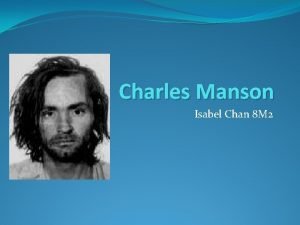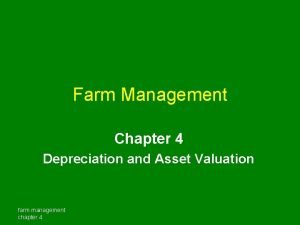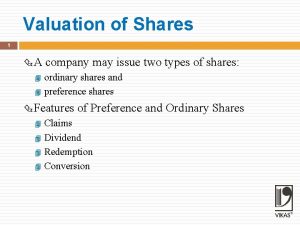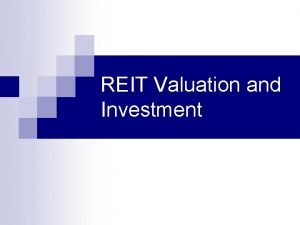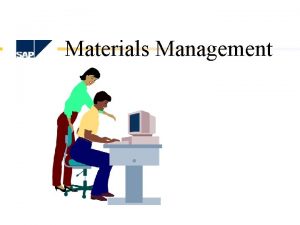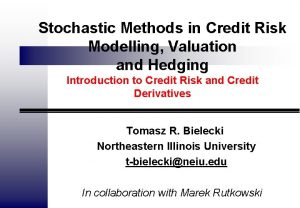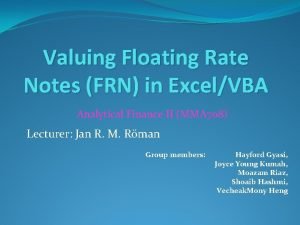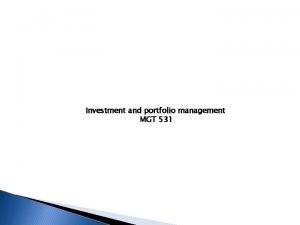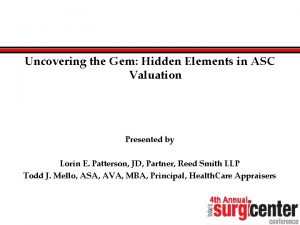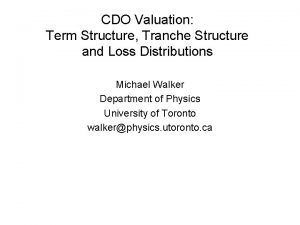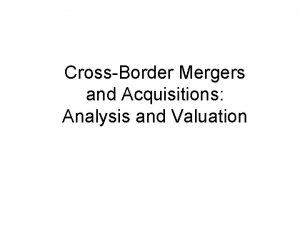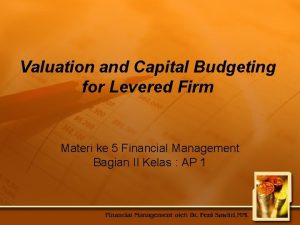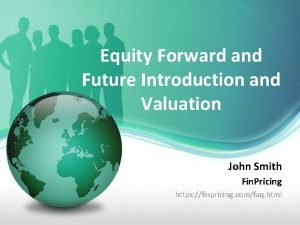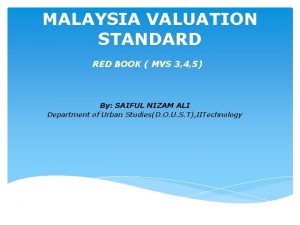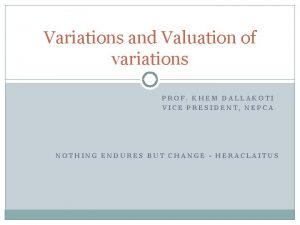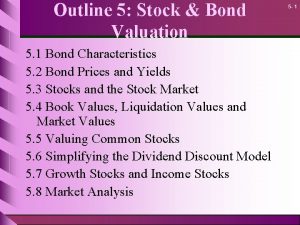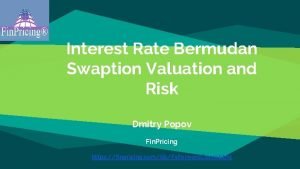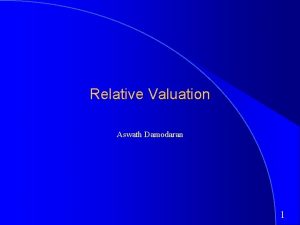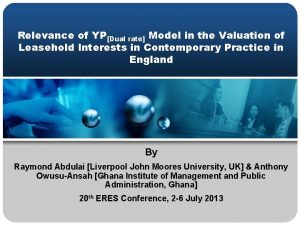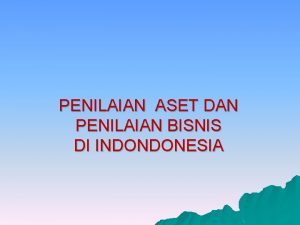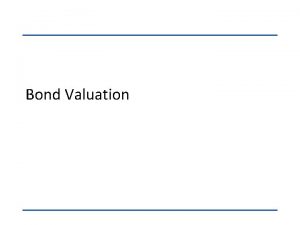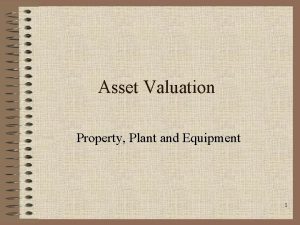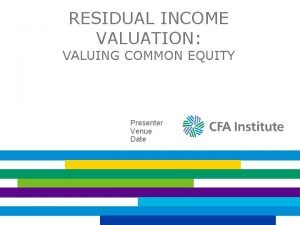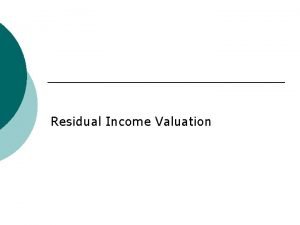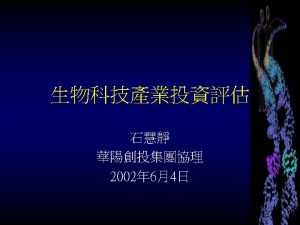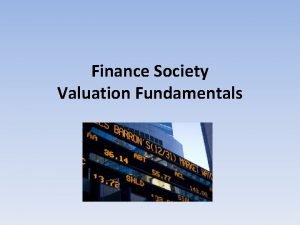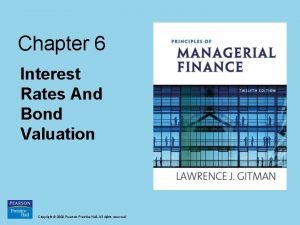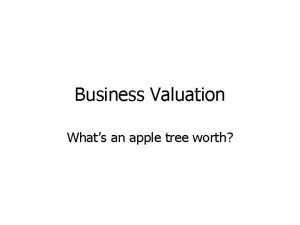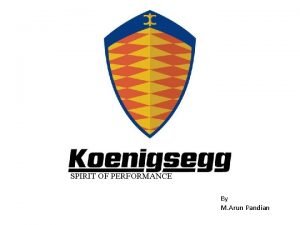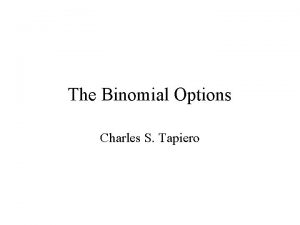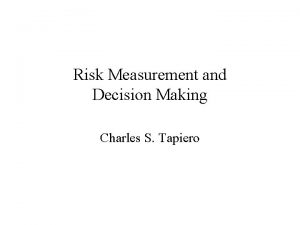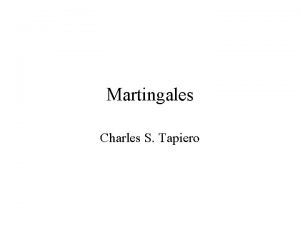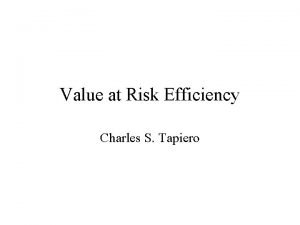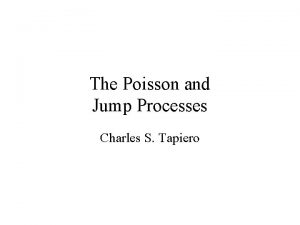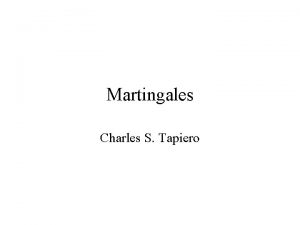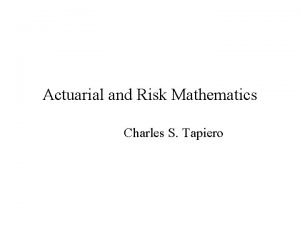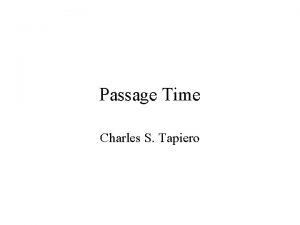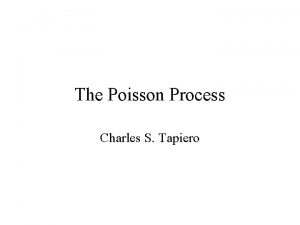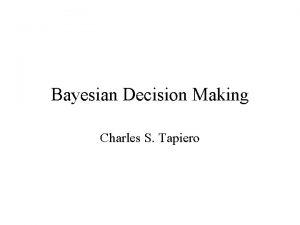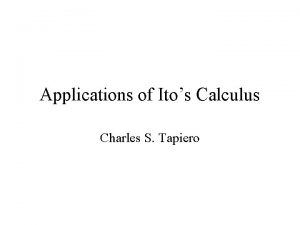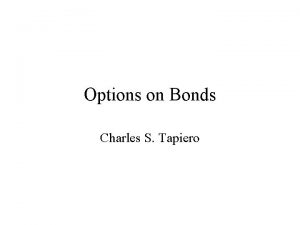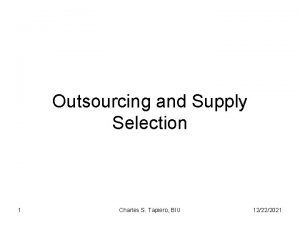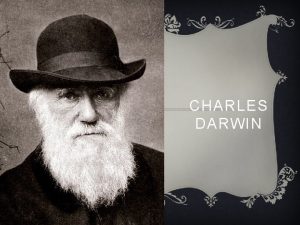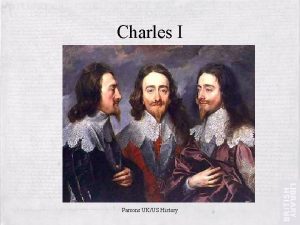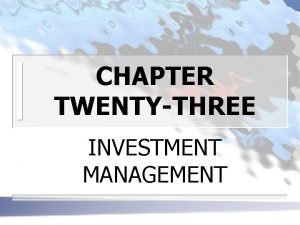Investment Valuation Charles S Tapiero 1 Traditional Valuation






































- Slides: 38

Investment Valuation Charles S. Tapiero 1

Traditional Valuation of Investments n Let be a prospective cash flow in future period i generated by an initial investment. Such cash flow may be known for sure or may be random. The techniques used to evaluate the cash flows and reach investment decisions are numerous, subsuming economic theories and attitudes towards time and risk. Some of the techniques consist in the following: Charles S. Tapiero 2

Valuation techniques n n n n n Replacement Value method Average Rate of Return Payback Method Internal Rate of Return Market Value Method (P/E ratio) Comparable Net Worth with Market value Discounted Cash Flow Accounting Rate of Return The CAPM and other models Charles S. Tapiero 3

In the following we shall consider each of these techniques and apply them. Charles S. Tapiero 4

Payback n Payback period: It is the number of years required for an investment to be paid back by a prospective cash flow. Firms may specify the number of years required for an investment to pay for itself Charles S. Tapiero 5

Example: Charles S. Tapiero 6

Pitfalls with the Payback Approach n n n Does not take into account the time value of money Ignores patterns of return within the payback period Ignores the benefits received subsequent to the payback of the money invested When ranking investment opportunities a slow payback is desirable in those investments promising an above average rate of return, a fast payback is desirable in those investments promising a rate of return below the average Note: the average rate of return being referred to is the rate of return for the industry of which the firm making the decision is part. Charles S. Tapiero 7

Accounting Rate of Return, ARR n Accounting Rate of Return (ARR): It is a ratio of average profit after depreciation and the average book value of the investment. There are of course, numerous accounting procedures in calculating these terms. A decision may be made to specify a required ARR. Any such ratio “better” than the ARR selected would imply that the investment project is accepted. Charles S. Tapiero 8

Example: Charles S. Tapiero 9

Net Present Value n Net Present Value (NPV): Uses a discount rate r for the time value of money. In this case, the NPV formula is given by: Charles S. Tapiero 10

n The discount rate r is usually called the rate of return. It consists of three components: the real interest rate, n n the inflation rate and a component adjusting for investment risk. A project’s internal rate of return (IRR) is the value solving the equation: NPV=0 Charles S. Tapiero 11

n The definition of an IRR is one of the essential problems one must deal with and estimate. It has, as a result, many variants, such as the FIE (Fixed Equivalent Rate of Return) which assumes a fixed IRR with funds generated by the investment, reinvested at the IRR. Such an assumption is not always realistic however, tending to overvalue investment projects. Charles S. Tapiero 12

n n The rate of return approach is widely used and extremely useful As stated earlier its usefulness is negated by the fact that one has to choose the rate of return at which future cash flows are generated. This choice involves often issues relating to the cost of capital. Charles S. Tapiero 13

Example: Solomon n n Let and let the future cash flow and future rates be: Then Solomon, suggest that the average rate of return be calculated by as follows: Charles S. Tapiero 14

Pitfalls are subtle …. n n It is possible under certain conditions to obtain several solutions to the rate of return. This is so because one is solving a polynomial for the exponent Ranking of projects can differ from method to method and therefore, the choice of the ranking rate of return can be difficult. Charles S. Tapiero 15

The Ranking error …… n n Fleischer discusses among other the ranking error problem. As an illustration: The case where only two alternatives are being considered, and these alternatives are usually exclusive in the sense that acceptance of one automatically excludes the other. Mutual exclusiveness may occur either because each of the alternatives is technically capable of fulfilling the same required function, or because insufficient capital is available for financing both alternatives. Regardless of the cost, selection of the proposal having the highest rate of return may result in an economically inferior solution. Charles S. Tapiero 16

Another case n n The case where more than two alternatives are being considered but, due to limited funds, not all of the projects may be accepted in the final capital budget. In this event, the notion of “financial mutual exclusiveness at the margin” is introduced to indicate that the last alternative accepted automatically precludes all others. For this reason, it is essential to define proper mutually exclusive capital budget packages. Charles S. Tapiero 17

Free Cash Flow (FCF) n It is defined as the cash flow minus the required investment in working capital and fixed assets. Free cash flow is used since a company, unlike a piece of machinery, is valued as if to continue doing business for the very long term Charles S. Tapiero 18

The traditional model for investment valuation is based on the estimation of future returns that are generated through the investment and their volatility. One such measure is the Dividend Discount Factor (DDM). The valuation of cash flows is reached through a number of techniques such as the : Model of Gordon-Shapiro Model of Bates etc. . . Charles S. Tapiero 19

Weighted average cost of capital r n n n Rb= borrowing rate Rr=Rate of return on equity shares Tc=Marginal income tax rate D=Market value of outstanding debt E=market value of outstanding equity Charles S. Tapiero 20

Gordon and Shapiro n The hypothesis is that the value of stock ought to be the present worth of the discounted stream of dividends that may be expected of the stock. Or Charles S. Tapiero 21

Where: n n n a share price at time t=0 The dividend expected at time t k=The rate of profit Charles S. Tapiero 22

In continuous time Charles S. Tapiero 23

Examples n In this example we will consider the choice between two alternative approaches to the problem of satisfying a 10 year crane service contract requirement. One approach uses a crane that will require a replacement at the end of 5 years. The alternative is to buy a more sophisticated crane that will last at least 10 years. Charles S. Tapiero 24

n Under the first alternative, the crane has a cost of 13, 000 USD and a salvage value at the end of the 5 years. The operating costs over the 5 years are: n n n C 1=2000 C 2=2200 C 3=5000 C 4= 2600 C 5= 3000 And the cost of capital is 7. 7 percents. Thus, Charles S. Tapiero 25

n The Present Value is Charles S. Tapiero 26

n n If at the end of the 5 years it is to be replaced by an identical crane having identical time cost patterns, then, The total present value of this 10 year or two cycle investment commitment is therefore the sum of the present worths at time zeroof both the original truck and its replacement, that is Charles S. Tapiero 27

n The alternative, the 10 years crane. It has the following data: Check the result: 42, 070 USD Charles S. Tapiero 28

Example: Rate of Return n An investment of 50, 000 USD is made in some port development project that will bear fruits only in 5 years at which time the investment plus some profit is recuperated. Thus, Charles S. Tapiero 29

Risk Adjusted Rates and Certainty Equivalents n n The Risk Adjusted Rates (RAR) and Certainty Equivalents (CE): We have seen earlier that the present value of an uncertain cash flow is given by its present value, using a risk adjusted discount rate, or: Another approach, consists in the use of a certainty equivalent and the risk free rate , or: Charles S. Tapiero 30

n In this case the risk adjusted discount rate and the certainty equivalent are related by: Charles S. Tapiero 31

Some well known indicators: 1) Sharpe Ratio 2) Treynor Ratio 3) Jensen’s Ratio Charles S. Tapiero 32

Applications Charles S. Tapiero 33

n n The approaches outlined above view valuation from the managerial firm's points of view. Other approaches have been suggested which view the firm's objectives' from the shareholder point of view. In some cases (frictionless markets), these approaches can be equivalent, while in others this may not be the case. In this approach, an investment should be selected to increase the value of shares. For this purpose, it is possible to use the Capital Asset Pricing Model (CAPM) approach to valuation which helps us define the risk adjusted discount rate to apply to a project. Such an approach can be useful, if properly applied, to value infrastructure projects. Charles S. Tapiero 34

The Risk Premium n n This approach can clarified further using expected utility. Define by P, the risk premium, then as we shall see later on, And therefore, in terms of the risk premium, we have: Charles S. Tapiero 35

Capital Asset Pricing Model (CAPM) n The CAPM defines the required rate of return of a future uncertain cash flow by: where is the return the market portfolio (a value of the weighted portfolio of all shares) earns over and above the riskless rate r. Charles S. Tapiero 36

In this model, the factor Beta is a measure of the share's risk relative to that of the market while risk adjustment is based on the covariance between the return and the market share portfolio. This is the case because individual investors can hold diversifiable risks while the covariance expresses non diversifiable risks. The valuation of an investment is thus: n With =Variance of Market return Charles S. Tapiero 37

Some selected references for traditional approaches n n n n n Alchian A. , Economic Replacement Policy, Report R-224, RM 2153, Rand Corporation, 1952 Bernhard R. H. , Discount methods for expenditure evaluation: A clarification of their assumptions, Journal of Industrial Engineering, Jan. Feb. 1962, 19 -27 Dean J. , Replacement Investments, Chapter VI in Capital Budgeting, Columbia University press, New York, 1951 Fisher L. , An algorithm for finding exact rates of return, Journal of Business, Jan 1966 Hirschleifer J. , On theory of optimal investment decision, Journal of Political Economy, August 1958 Pitchford J. D. and A. J. Hagger, A note on the marginal efficiency of capital, The Economic Journal, Sept. 1958 Solomon E. , The arithmetic of capital budgeting decisions, Fournal of Business, April 1956 Solomon E. , The Management of Corporate Capital, Free Press, Glencoe, Ill, 1959 Terborgh J. , Business, Investment Management, Machinery and Allied Product Institute, Washington D. C. 1967 Charles S. Tapiero 38
 Valuation theories of fixed income securities
Valuation theories of fixed income securities Fixed investment and inventory investment
Fixed investment and inventory investment Charles manson childhood
Charles manson childhood Valuation of farm assets
Valuation of farm assets Valuation of shares
Valuation of shares Vertical scope stock
Vertical scope stock Split valuation
Split valuation Credit valuation adjustment
Credit valuation adjustment Frn valuation
Frn valuation Corporate valuation model
Corporate valuation model T-bill yield formula
T-bill yield formula Equity analysis and valuation
Equity analysis and valuation Fuze workstation
Fuze workstation Gem asc
Gem asc Cdo valuation
Cdo valuation Contingent valuation method
Contingent valuation method Cross border valuation
Cross border valuation Valuation and capital budgeting for the levered firm
Valuation and capital budgeting for the levered firm Equity forward
Equity forward Red mvs definition
Red mvs definition Valuation of variations
Valuation of variations Valuation of stocks and bonds
Valuation of stocks and bonds Bermudan swap
Bermudan swap Relative valuation
Relative valuation Yp dual rate calculator
Yp dual rate calculator Asset based valuation
Asset based valuation Volbeat corporation has bonds on the market
Volbeat corporation has bonds on the market Ibm valuation
Ibm valuation Property plant and equipment
Property plant and equipment Calculate residual income
Calculate residual income Residual income models
Residual income models Startup valuation model
Startup valuation model Avco stock valuation
Avco stock valuation Trading comparables
Trading comparables Chapter 5 bonds bond valuation and interest rates solutions
Chapter 5 bonds bond valuation and interest rates solutions Valuation model of mnc
Valuation model of mnc Chapter 6 interest rates and bond valuation
Chapter 6 interest rates and bond valuation How to value an apple tree
How to value an apple tree Spirit of arun
Spirit of arun


